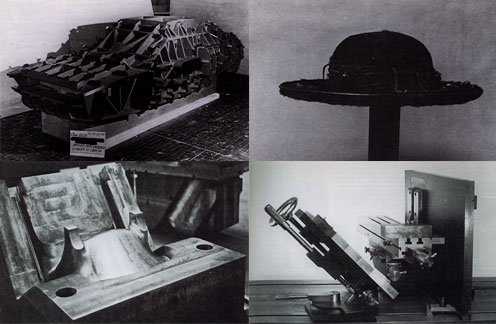In what is probably the most ideologically analytical essay ever written about paperweights, curator Barbara Casavecchia notes that many of the 60 paperweights she selected from Enzo Mari’s collection “are the product of a manual labor–serving as fragmented evidence of the persistence of non-alienating forms of work, specifically within the craftsman-like dimension inherent to production that Mari has investigated for years.”
One incarnation of Mari’s investigation was an exhibition and discussion forum he organized in 1981 titled, “Dov’e l’artigiano”/”Where is the crafstman”. It was presented first at Fortezza da Basso in Florence, and then at the Triennale in Milan. There was a catalogue published–which I can’t find anywhere–and at least one review–which I can only find a few quotes from, but otherwise, the Italians have not yet processed or digitized their contemporary design history yet.
In his latest book, Venticinque modi per piantare un chiodo/25 ways to drive a nail, Mari says the objective was to “illustrate the unresolved ambiguity of the relationship between industrial design and ‘handmade.'”
Excerpts from an Ottagono review of “Dov’e l’artigiano” place the show and Mari’s critical view of the alienating labor conditions of mass production at the center of the debate over Italian design, culture, business, even a national identity of sorts. On the one hand, some Italian producers, still modernizing, hid the fact that their consumer products were partially made by hand because they “did not want to lose the noble title” of industrial design. And others hid the fact that they’d begun using industrial manufacturing processes because they didn’t want “to lose the prestigious title of an object ‘made by hand.'”

As he had done in 1973 with his autoprogettazione plans, exhibition, and product line, Mari eschewed theoretical arguments in favor of a “didactic exhibition” of objects and the close analysis of their creation. For the show he uncovered hundreds of examples of artisanal and craftsman-like processes being used to make mass-produced industrial design. Here are the objects and categories I’ve been able to find so far:
- Industrial prototypes and models made by craftsmen, such as hand-formed auto body parts by Italdesign’s Giorgetto Giugiaro and Aldo Mantovani for Alfa Romeo [top left, I think]
- Scale models and testing prototypes of turbines.
- A hand-made mold for high-quality plastic chairs [bottom left].
- The schematic drawing for an integrated circuit, which apparently took over 1800 man-hours to create. [I believe it]
- “Technological masterpieces” such as US nuclear submarines, one-off industrial objects.
- An 18th-century-style table with legs “built in series with industrial machinery, but finished with a stroke of the chisel to make it ‘unique.'”
- A Borsalino custom-made for the Pope [top right].
- A machine-like sculpture by Mari collaborator Paolo Gallerani [bottom right].
Oh yeah, and the whole show took place inside a geodesic dome.
I’ll add more objects and pictures if/as I find them. It’s hard to process a 30-year-old exhibit you’ve only just found out about. But it makes me think of things like, well, obviously, pen plotters and that insane William Shatner integrated circuit drawing movie. And NASA workers using giant clothespins to glue the mylar strips toghether for Project Echo satelloons. And Richard Serra sculptures made in defunct shipyards and Richard Prince car hoods. And hand-embroidered Gap kids’ dresses that turn out to have been made by children in India. And etsy and custom Nikes and pre-stressed jeans. And Ikea furniture that offloads all the non-alienating labor processes onto the customer.
Which is all by way of saying I have no grand theories on the current state of the relationship between craft and industrial production; but I think they’ve turned out to be not quite as incompatible as they seemed in 1981.
LINKS/RELATED
This all started with the catalogue essay for Enzo Mari: Sixty Paperweights, An Intellectual Work, which just closed in Berlin. [kaleidoscope-press.com, tanyaleighton.com]
Maddamura’s discovery of the Ottagono review is one of the few online sources of info on the “Dove’e l’Artigiano” show [image, too: maddamura.eu]
Mari’s new book, 25 Ways to Drive A Nail, is not available in English yet. [google books tho]
